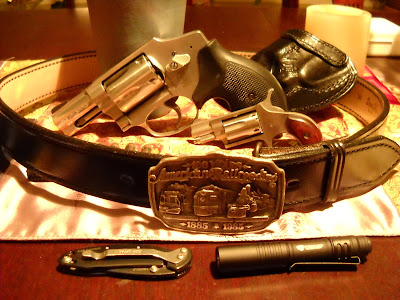
Before I start, there are metric tons of gun bloggers that carry 1911s and shoot them in competition. They're probably better versed in them than I am. Having said that, I've never let my ineptitude stop me from talking before, so why start now?
Stopping PowerLegendary and well-deserved. 230 grain FMJs or LRNs work wonders against heavily-clothed goblins. 185gr+p JHPs are nothing to scoff at, either.
ReliabilityOnce you find a load and a magazine that your particular 1911 likes, you'll be fine as long as you keep the gun clean and well-lubed. I'd suggest that you number all of your magazines with a paint pen and take notes about any failures that you have during practice or training. Magazines will make or break your 1911. Don't be cheap, hopeful, lax in maintenance, or sentimental about them.
Ease and flexibility of useThey take a little more getting used to than, say, a Glock or a snubbie, but you'll usually be rewarded with a very accurate and hard-hitting defensive handgun. Reloads with them are a breeze with a little practice and a slightly beveled magwell. They tend to be less flexible than snubbies, however. Speaking of....
Size, weight, and concealibilityFull-size 1911s are long and heavy. They're thin enough to make them kind of comfortable when carying inside the waistband, but many small and thin-framed people will have a hard time concealing one. You'll also know for sure that you've been carrying all day if you've had a 1911 on your hip. For the most part, 1911s are best carried in traditional hip holsters, shoulder holsters, or a SmartCarry. My preferred rig is a Galco Summer Comfort IWB holster worn underneath a sweater, jacket, or open shirt.
Accuracy and trigger pullI touched on this earlier, but a good 1911 is an amazingly accurate gun. Even the worst modern factory triggers are pretty good. Most loads are what I would describe as moderate in recoil, which will allow you to make better and faster follow-up shots.
CustomizationThe 1911 is one of the most easily and most often customized handgun platform in existence. Sights, grips, barrels, slides, hammers, safeties, guide rods, triggers... you name it, it can probably be changed to something that suits you.




